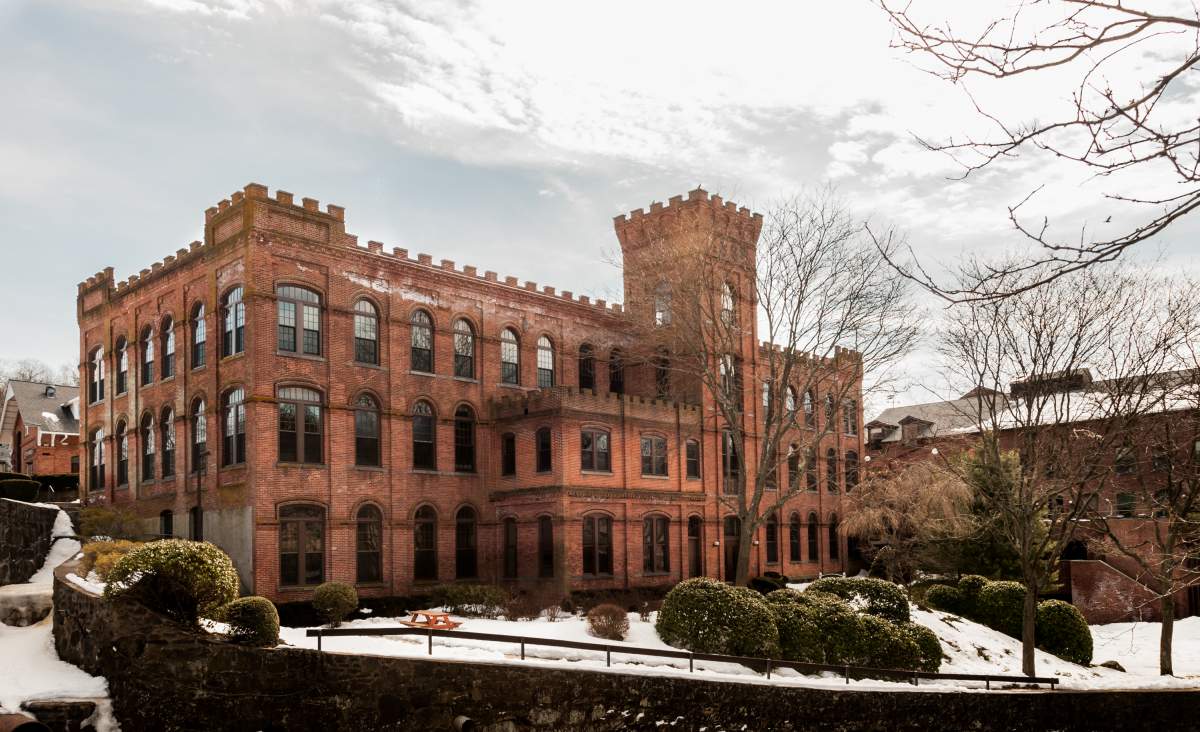

Irish immigrants were the majority of the workforce in the mill in the late nineteenth and early twentieth centuries. The first mill at this location was Jared V. Peck's cotton mill which began operations in 1790. Peck sold the mill in 1820 and a series of owners constructed new buildings on the site as their businesses grew. The mill was purchased by Tingue, House and Company in 1875.
 Photo: New Mill, view southwest. (Tod Bryant)
Photo: New Mill, view southwest. (Tod Bryant)
They produced felt as well as woolen, cotton and mixed goods in this location. Their business prospered and they constructed new buildings in 1875 and1878 before building the "New Mill" as the centerpiece of their complex in 1881. It was considered a technologically advanced building at the time, since it had the area's first telephone system installed in 1882 and one of the earliest Edison electric generators for lighting.
The business continued under various owners and names until 1977. GAF Corporation purchased the mill in 1967 and decided to close it in 1977. The mill buildings and surrounding thirty acres were bought by Greenwich Associates in 1978 and redeveloped for office, residential and retail use.
In the nineteenth and early twentieth centuries, the mill usually ran eleven hours each day with a workforce of about two hundred men. Workers in the 1840s were predominantly English-born and the mill owner built them an Episcopal Chapel because there were only Baptist and Methodist churches in the area. The 1860 US Census shows forty Englishmen in Glenville, but by 1880 they were heavily outnumbered by 256 Irish – over half the population of the village.
Most of the men in these families worked in the mill. The growing number of Irish Catholics in the area organized St. Paul Roman Catholic Church as a mission of St. Mary's in Greenwich. The church building was erected in 1902 and its stained glass windows bore the names of their Irish donors. The church burned in 1967 and the congregation built a new St. Peters near the center of Greenwich.
These Irish workers also contributed to the development of the village surrounding the mill. A reminder of their presence is the Phillip Finnegan House at 28 Riverside Road. It is set back from the street and features Queen Anne elements, including a front porch and a basement- level side porch, both retaining their turned posts and curvilinear brackets, the latter perforated at the front porch.
Levey, Lee, "The Mill, Glenville, CT' A Social, Economic and Architectural History," unpublished manuscript, Greenwich, 1979.
Kershkus, Nils, "Glenville Historic District," National Register of Historic Places nomination, 2006.
This building has a crenellated roof with a corbelled table at the cornice. The facade is divided into eight bays by brick pilasters and there are Romanesque arched windows in each bay. The cornices of the end bays are slightly taller than the center roof line to give the effect of corner towers. The center of the facade is dominated by a projecting four story square tower with a crenellated roof and a two story block , two bays wide attached to its north elevation
The Glennville Mill building is part of a four building former mill complex in the center of a residential and commercial area approximately two miles northwest of the center of Greenwich. Some of of the houses and other buildings were originally part of a mill village.
Date(s): Built 1881 Style(s): Gothic Revival Historic Use: Mill Present Use: Offices, retail Builder: George Mertz
Accessibility:
Exterior visible from public road.
Interior accessible (during business hours).
The Irish experience has had a profound impact on Connecticut's past, and its narrative spans all periods of the state's history and touches every one of its eight counties and 169 towns.
